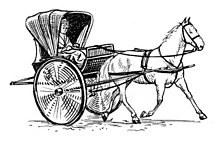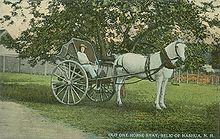A chaise (/ʃeɪz/ shayz), sometimes called shay, is a light two-wheeled carriage for one or two people. It may also have a folding hood.[1]: 55 The coachmaker William Felton (1796) considered chaises a family of vehicles which included all two-wheel one-horse vehicles such as gigs and whiskies, whereas a similar carriage pulled by two-horses was considered a curricle.[2]: 80


Etymology
editThe name, in use in England before 1700, came from the French word chaise, meaning chair.[3][a] The spelling shay is a colloquial variant of chaise, particularly in North America.[5]: 146 A variant chay is slang and sometimes refers to other types of vehicle.[6]
Design
editThe chaise is a two-wheeled carriage pulled by a single horse, usually with a chair-backed seat suitable for one or two persons. Felton writes that it is the finished look which dictates which type of chaise they are, but their construction is one of only two types: "the one, a chair-back body for gig or curricle, which hangs by braces—the other, a simple half-pannel whiskey, which fixes on the shafts".[7]: 45
A light chaise having two seats is a double chair.[citation needed] A chaise-cart is a light carriage used for transporting lightweight goods instead of people.[1]: 55 A sjees is often referred to as a Friesian chaise.[4]: 128 A post chaise is a vehicle designed for private long-distance travel via posting stations, originally with two-wheels (known as chaise-a-porteurs or posting chariot) but later becoming a four-wheeled vehicle while retaining the word "chaise" in the name.[5]: 42 [4]: 217
Whiskey
editA whiskey (also spelled whisky, plural whiskies [2]: 300 ) was a lightweight two-wheeled chaise that seated one or two persons. It was so named because it would "whisk" along at great speeds. It was often constructed with caned sides and no dashboard which further lightened the vehicle. Shafts were fitted under the body and it was hung on shallow-sideways platform springs. It was popular in the late 18th and early 19th centuries.[5]: 173 [4]: 295
American shay
edit
According to Berkebile, "The chaise was one of the most popular vehicles used in colonial America, and did not pass from the scene until mid-nineteenth century. It was widely used by all social classes."[2]: 82 In America, the chaise was constructed with a standing or falling hood, whereas the same vehicle without a hood was called a chair. The body was either directly on the shafts or used leather thoroughbraces, or was constructed with wooden cantilever springs and braces which is thought to be an American development.[2]: 80–2
The vehicle was commonly called a shay in New England, and the word shay was further popularized by Oliver Wendell Holmes's 1858 poem The Deacon's Masterpiece, or The Wonderful One-Hoss Shay.[2]: 82, 249 [8]
One-hoss shay
editIn economics, the term "one-hoss shay" is used, following the scenario in Holmes' poem, to describe a model of depreciation, in which a durable product delivers the same services throughout its lifetime before failing, or being retired, with no salvage value.[9][10]: S150
See also
edit- Post chaise — a coach for long distance travel using posting stations
- Bath chair — early form of wheelchair sometimes called a chaise or handchaise
Notes
edit- ^ Chaise: Taken from the French word 'chair' and used generally in the naming of various vehicles such as the Post Chaise. In the 1800s numerous French designs and ideas were copied in England which inevitably led to the common use of French words in describing that which became generally accepted as an English vehicle. The Char-a-Banc is a classic example.[4]: 65
References
edit- ^ a b Cowie, L.W. (1996). The Wordsworth Dictionary of British Social History. Wordsworth Editions. ISBN 1-85326-378-8. OL 22262013M.
- ^ a b c d e Berkebile, Donald H. (1978). Carriage Terminology: An Historical Dictionary. Smithsonian Institution Scholarly Press. ISBN 9781935623434. OL 33342342M.
- ^ Chisholm, Hugh, ed. (1911). . Encyclopædia Britannica. Vol. 5 (11th ed.). Cambridge University Press. p. 802.
- ^ a b c d Walrond, Sallie (1979). The Encyclopaedia of Driving. Country Life Books. ISBN 0600331822. OL 4175648M.
- ^ a b c Smith, D.J.M. (1988). A Dictionary of Horse Drawn Vehicles. J. A. Allen & Co. Ltd. ISBN 0851314686. OL 11597864M.
- ^ "chay n., also chay-cart, shay". Green's Dictionary of Slang.
- ^ Felton, William (1996) [1796]. A Treatise on Carriages. Astragal Press. ISBN 1879335700. OL 21753408M.
- ^ Holmes, Oliver Wendell (1905). The one-hoss shay, with its companion poems. Illustrated by Howard Pyle. Houghton, Mifflin and Company. OL 6961416M.
- ^ "One-Hoss Shay". OECD. Glossary of Statistical Terms. Archived from the original on 31 October 2013. Retrieved 30 May 2013.
- ^ Diewert, Erwin; Wei, Hui (February 2017). "Getting Rental Prices Right for Computers: Reconciling Different Perspectives on Depreciation". Review of Income and Wealth. 63 (s1): S149–S168. doi:10.1111/roiw.12249.
The "one hoss shay" or "light bulb" model of depreciation assumes that the service flow of the asset is constant over the lifetime L of the asset and then it is retired at the end of L periods of use.

